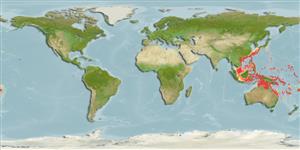Bivalvia |
Cardiida |
Cardiidae
Environment: milieu / climate zone / djupintervall / distribution range
Ekologi
; djupintervall 0 - 20 m (Ref. 104607). Tropical
Indo-West Pacific.
Length at first maturity / Size / Weight / Age
Könsmognad: Lm ? range ? - ? cm
It is found in littoral and sublittoral areas with sandy muddy bottoms, and often in sheltered habitats in association with seagrass (Ref. 104607). Depth estimate based on Family (Ref. 108635).
Life cycle and mating behavior
Könsmognad | Reproduktion | Lek | Eggs | Fecundity | Larvae
Members of the class Bivalvia are mostly gonochoric, some are protandric hermaphrodites. Life cycle: Embryos develop into free-swimming trocophore larvae, succeeded by the bivalve veliger, resembling a miniature clam.
van der Meij, S.E.T., R.G. Moolenbeek and B.W. Hoeksema 2009 Decline of the Jakarta Bay molluscan fauna linked to human impact. Marine Pollution Bulletin 59:101-107. (Ref. 83672)
IUCN Red List Status
(Ref. 130435: Version 2025-1)
CITES status (Ref. 108899)
Not Evaluated
Not Evaluated
Threat to humans
Harmless
Human uses
| FishSource |
Verktyg
Ytterligare information
Trophic EcologyFood items (preys)
Födosammansättning
Födointag
Predatorer
Population dynamicsTillväxt
Max. ages / sizes
Length-weight rel.
Length-length rel.
Length-frequencies
Mass conversion
Abundans
PhysiologySyreförbrukning
Human RelatedStamps, coins, misc.
Internet-källor
Estimates based on models
